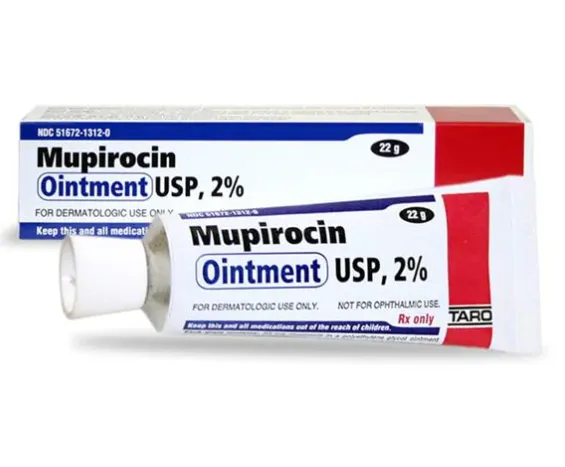Mupirocin Topical Dosage
Medically reviewed by Drugs.com. Last updated on Jul 24, 2025.
Applies to the following strengths: 2%
Usual Adult Dose for:
Usual Pediatric Dose for:
Additional dosage information:
Usual Adult Dose for Secondary Cutaneous Bacterial Infections
Topical cream: Apply a small amount to the affected area 3 times a day for 10 days.
Use: For the treatment of secondarily infected traumatic skin lesions (up to 10 cm in length or 100 cm2 in area) due to susceptible strains of Staphylococcus aureus and Streptococcus pyogenes
Usual Adult Dose for Nasal Carriage of Staphylococcus aureus
Nasal ointment: Apply about one-half of the tube contents into 1 nostril and the other half into the other nostril twice a day (morning and evening).
Duration of therapy: 5 days
Use: For the eradication of nasal colonization with methicillin-resistant S aureus (MRSA) in patients and healthcare workers as part of a comprehensive infection control program to reduce risk of MRSA infection among high-risk patients during institutional outbreaks of MRSA infections
Usual Adult Dose for Impetigo
Topical ointment: Apply a small amount to the affected area 3 times a day.
Use: For the topical treatment of impetigo due to S aureus and S pyogenes
Usual Pediatric Dose for Secondary Cutaneous Bacterial Infections
3 months or older:
Topical cream: Apply a small amount to the affected area 3 times a day for 10 days.
Use: For the treatment of secondarily infected traumatic skin lesions (up to 10 cm in length or 100 cm2 in area) due to susceptible strains of S aureus and S pyogenes
Usual Pediatric Dose for Nasal Carriage of Staphylococcus aureus
12 years or older:
Nasal ointment: Apply about one-half of the tube contents into 1 nostril and the other half into the other nostril twice a day (morning and evening).
Duration of therapy: 5 days
Use: For the eradication of nasal colonization with MRSA in patients and healthcare workers as part of a comprehensive infection control program to reduce risk of MRSA infection among high-risk patients during institutional outbreaks of MRSA infections
Usual Pediatric Dose for Impetigo
2 months or older:
Topical ointment: Apply a small amount to the affected area 3 times a day.
Use: For the topical treatment of impetigo due to S aureus and S pyogenes
Renal Dose Adjustments
Data not available
Comments:
- The polyethylene glycol-based ointment formulation should not be used in conditions where large amounts of polyethylene glycol may be absorbed, especially in patients with moderate or severe renal dysfunction.
Liver Dose Adjustments
Data not available
Precautions
Safety and efficacy have not been established in patients younger than 2 months (topical ointment), 3 months (topical cream), or 12 years (nasal ointment).
Consult WARNINGS section for additional precautions.
Dialysis
Data not available
Other Comments
Administration advice:
- Nasal ointment: After application (to spread drug throughout the nares), close nostrils by pressing together and release the sides of the nose repeatedly for about 1 minute; do not apply this product concomitantly with other intranasal products.
- Topical cream and ointment: For external use only; may cover treated area by gauze dressing if desired
- Do not use the polyethylene glycol-based ointment formulation in conditions where large amounts of polyethylene glycol may be absorbed.
Storage requirements:
- Nasal ointment: Store at 20C to 25C (68F to 77F); excursions permitted to 15C to 30C (59F to 86F); do not refrigerate.
- Topical cream: Store at or below 25C (77F); do not freeze.
- Topical ointment: Store at 20C to 25C (68F to 77F).
General:
- Limitations of use (nasal ointment): Data insufficient to establish safety and efficacy of this product as part of an intervention program to prevent autoinfection of high-risk patients from their own nasal carriage of S aureus; data insufficient to recommend use of this product for general prophylaxis of any infection in any patient population
- Nasal ointment: The single-use tube will deliver about 0.25 g of the product per nostril.
- Topical cream and ointment: If clinical response is not seen within 3 to 5 days, patients should be reevaluated.
Patient advice:
- Avoid contact of this drug with the eyes; if it gets in or near the eyes, rinse thoroughly with water.
- Stop this drug and consult healthcare provider if sensitization or severe local irritation occurs while using the nasal ointment, or if irritation, severe itching, or rash occurs while using the topical cream or ointment.
- Nasal ointment: Wash hands before and after applying this drug; after application, press the sides of the nose together and gently massage to spread the drug throughout the inside of the nostrils. Avoid missing doses and complete the entire course of therapy. Consult the Patient Information Leaflet for additional information.
- Topical cream and ointment: Contact healthcare provider if no improvement seen in 3 to 5 days.
Frequently asked questions
- What are the best antibiotics for a boil?
- Can mupirocin heal or help with eczema?
- Can I use mupirocin ointment for diaper rash?
- Can mupirocin be used for athletes foot?
- Can mupirocin cream be used for bed sores?
More about mupirocin topical
- Compare alternatives
- Pricing & coupons
- Reviews (52)
- Drug images
- Side effects
- During pregnancy
- Support group
- Drug class: topical antibiotics
- Breastfeeding
- En español
Patient resources
Other brands
Bactroban, Centany, Centany AT, Centany AT Kit
Professional resources
Other brands
Bactroban, Centany, Bactroban Nasal, Centany AT, Pirnuo
Related treatment guides
See also:
Further information
Always consult your healthcare provider to ensure the information displayed on this page applies to your personal circumstances.


